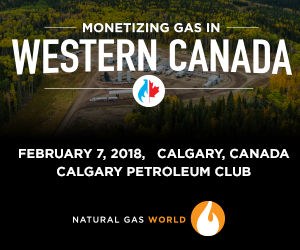Canadian Gas Producers Face Bleak 2018: Analyst
The Canadian natural gas market is looking bleak for 2018, with average prices expected to be sharply lower and little prospect for near-term improvement, GMP FirstEnergy Securities analyst Martin King says in a December 12 quarterly gas outlook report.
“Canadian natural gas prices have deteriorated significantly in recent months and now appear to be plagued by numerous problems spanning the poor start to the current winter, deliverability issues, high storage, surging supplies, erosion of market share, and very poor regional pricing,” King wrote. “We have made substantial downward adjustments to our Canadian price outlook to reflect these conditions. Any price improvement will be slow and not until 2H18.”
GMP FirstEnergy is now projecting the benchmark Canadian gas price at the AECO hub will average just C$2.19/’000 ft3 in 2017, down from its previous forecast of C$2.57/’000 ft3, and just $2.21/’000 ft3 next year, down from the investment bank’s earlier forecast of C$3.61.
The prospect of a colder winter had provided some earlier optimism that Canadian gas prices would recover in 2018, King said, but that optimism has been “completely demolished” by a feeble start to the current heating season and the likelihood that structural problems that plagued Canadian producers in 2017 will persist into 2018.
“Moreover, a significant surge in supply in the late stages of this year could (overwhelm) the current capacity of the pipeline system to get it all to market in 2018,” King’s note said.
In 2017, TransCanada declared that while maintenance continued on its system, interruptible service would not be available to move excess production into storage, the market’s usual safety valve in times of strong supply. The resulting supply bubble sent AECO prices crashing into negative territory in the summer of 2017; the pressure was only relieved later in the fall when weather-related demand strengthened and TransCanada’s maintenance programs wrapped up, allowing at least a partial rest of AECO pricing heading into the winter heating season.
That reset, however, may not last very long, King said, noting that the potential for oversupply conditions in the US is creating downward price pressure throughout the North American gas market. For AECO and other western Canadian pricing hubs — Westcoast Energy’s Station 2 and the Alliance ATP in particular — a series of other issues may bring even greater downside risks in 2018 and 2019.
Chief among these issues are:
- Continuing strong supply additions, principally from the Montney and Deep Basin;
- An expectation that maintenance issues and interruptible transportation restrictions that hammered AECO prices last summer will be repeated in 2018;
- A significant lack of takeaway capacity from other parts of the Western Canadian Sedimentary Basin (both the Alliance system, which takes liquids-rich gas southeast into Midwest markets, and the Westcoast system, which accesses markets in the Pacific Northwest and California, are effectively full);
- Concerns that storage levels could end up being very high next spring if warm weather continues through the winter;
- A loss of market share by western Canadian gas into Ontario as new Appalachian supplies push into the Dawn hub with the completion of the Rover pipeline and expectations that the NEXUS pipeline will be completed by early 2019.
“Between Rover and Nexus, this could deliver an incremental 2bn ft³/day of US Northeast gas (supply) into Dawn,” King wrote. “The potential competition is further sinking the Dawn-Nymex price spread (traditionally a premium for Dawn versus Nymex) and… feeding back to softer prices for AECO.”
To deal with a market that “appears to have completely fallen overboard”, King suggests that producers will be forced to shut in production, reduce drilling to limit supply additions, hope for more demand growth within Alberta and for additional takeaway capacity on the Westcoast and Alliance systems or wait for longer term relief in the form of LNG exports from either the US West Coast and/or BC.
“With optimism rising that the LNG Canada project might receive a positive FID in 2018, this would provide a long-desired export outlet for Canadian gas completely separate from the US,” King wrote, noting that the Jordan Cove LNG project in Oregon might also provide an option for Canadian producers to reach Asian markets. Assuming FID on each in 2018, both those plants could be in service by 2023, representing total inlet demand of some 3bn ft³/day of Canadian gas.


